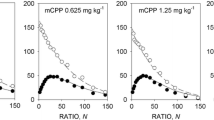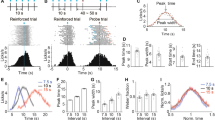Abstract
This experiment examined the effect of destroying the 5-hydroxytryptaminergic (5HTergic) pathways on rats' ability to discriminate between two durations. Rats received injections of 5,7-dihydroxytryptamine into the median and dorsal raphe nuclei or sham lesions. They were trained to press lever A following a 2-s presentation of a light and lever B following an 8-s presentation of the light. For some rats, the levers were inserted into the chamber immediately after stimulus presentation (“no-poke-requirement”); for others, the levers were not inserted until a flap covering the food tray positioned midway between the levers had been depressed (“poke-requirement”). When stable performance was attained, “probe” trials were introduced in which the light was presented for intermediate durations. Logistic functions were derived relating percent choice of lever B to log stimulus duration. Under the “no-poke-requirement” condition, the bisection point (duration yielding 50% choice of lever B) was shorter in the lesioned rats than in the control rats. Under the “poke-requirement” condition, this effect of the lesion was attenuated. There was no effect of the lesion on the Weber fraction under either condition. The levels of 5HT and 5-hydroxyindoleacetic acid were reduced in the brains of the lesioned rats, but the levels of noradrenaline and dopamine were not altered. It is proposed that rats may attain accurate timing under the interval bisection task by moving from one lever to the other during stimulus presentation; this movement may be facilitated by destruction of the 5HTergic pathways. Accurate timing is still possible when this movement is suppressed by the introduction of a “poke requirement”; however, in this case timing is not affected by 5HT depletion.
Similar content being viewed by others
References
Altman HG, Normile HJ (1988) What is the nature of the role of the serotonergic nervous system in learning and memory; prospects for development of an effective treatment strategy for senile dementia. Neurobiol Aging 9:627–638
Baumgarten HG, Jenner S, Bjorkland A, Klemm HP, Schlossberger, HG (1982) Serotonin neurotoxins. In: Osborne NN (ed) Biology of serotonin transmission. Wiley, Chichester
Catania AC (1970) Reinforcement schedules and psychophysical judgements: a study of some temporal properties of behavior. In: Schoenfeld WN (ed) The theory of reinforcement schedules. Appleton-Century-Crofts, New York, pp 1–42
Chatlosh DL, Wassermann EA (1987) Delayed temporal discrimination in pigeons: a comparison of two procedures. J Exp Anal Behav 47:299–309
Church RM, Deluty MZ (1977) Bisection of temporal intervals. J Exp Psychol [Anim Behav Proc] 3:216–228
Deakin JFW (1983) Roles of serotonergic systems in escape, avoidance and other behaviours. In: Cooper SJ (ed) Theory in psychopharmacology, vol. 2. Academic Press, New York
Fetterman JG, Killeen PR (1992) Time discrimination inColumba livia andHomo sapiens. J Exp Psychol [Anim Behav Proc] 18:80–94
Gibbon J (1991) Origins of scalar timing. Learn Motiv 22:3–38
Graham S, Ho M-Y, Bradshaw CM, Szabadi E (1994) Facilitated acquisition of a temporal discrimination following destruction of the ascending 5-hydroxytryptaminergic pathways. Psychopharmacology 116:373–378
Heffner TG, Hartman JA, Seiden LS (1988) A method for the regional dissection of the rat brain. Pharmacol Biochem Behav 13:453–456
Killeen PR, Fetterman JG (1988) A behavioral theory of timing. Psychol Rev 95:274–295
Lewis D (1960) Quantitative methods in psychology. Springer, Berlin Heidelberg New York
McEntee WJ, Crook TH (1991) Serotonin, memory, and aging brain. Psychopharmacology 103:143–149
Morrissey G, Wogar MA, Bradshaw CM, Szabadi E (1993) Effect of lesions of the ascending 5-hydroxytryptaminergic pathways on timing behaviour investigated with an interval bisection task. Psychopharmacology 112:80–85
Morrissey G, Ho M-Y, Wogar MA, Bradshaw CM, Szabadi E (1994) Effect of lesions of the ascending 5-hydroxytryptaminergic pathways on timing behaviour investigated with the fixed-interval peak procedure. Psychopharmacology 114:463–468
Platt JR, Davis ER (1983) Bisection of temporal intervals by pigeons. J Exp Psychol [Anim Behav Proc] 9:160–170
Soubrié P (1986) Reconciling the role of central serotonin neurons in human and animal behavior. Behav Brain Sci 9:319–364
Treisman M (1963) Temporal discrimination and the indifference interval: implications for a model of the “internal clock”. Psychol Monogr 77:1–31
Treisman M, Cook N, Naish, PLN, MacCrone JK (1994) The internal clock: electroencephalographic evidence for oscillatory processes underlying time perception. Q J Exp Psychol 47A:241–289
Winer BJ (1971) Statistical principles in experimental design, 2nd edn. McGraw-Hill Kogakusha, Tokyo
Wogar MA, Bradshaw CM, Szabadi E (1991) Evidence for an involvement of 5-hydroxytryptaminergic neurones in the maintenance of operant behaviour by positive reinforcement. Psychopharmacology 105:119–124
Wogar MA, Bradshaw CM, Szabadi E (1992) Impaired acquisition of temporal differentiation performance following lesions of the ascending 5-hydroxytryptaminergic pathways. Psychopharmacology 107:373–378
Wogar MA, Bradshaw CM, Szabadi E (1993a) Effects of lesions of the ascending 5-hydroxytryptaminergic pathways on choice between delayed reinforcers. Psychopharmacology 111:239–243
Wogar MA, Bradshaw CM, Szabadi E (1993b) Does the effect of central 5-hydroxytryptamine depletion on timing depend on motivational change. Psychopharmacology 112:86–92
Author information
Authors and Affiliations
Rights and permissions
About this article
Cite this article
Ho, M.Y., Al-Zahrani, S.S.A., Velazquez Martinez, D.N. et al. The role of the ascending 5-hydroxytryptaminergic pathways in timing behaviour: further observations with the interval bisection task. Psychopharmacology 120, 213–219 (1995). https://doi.org/10.1007/BF02246196
Received:
Revised:
Issue Date:
DOI: https://doi.org/10.1007/BF02246196




